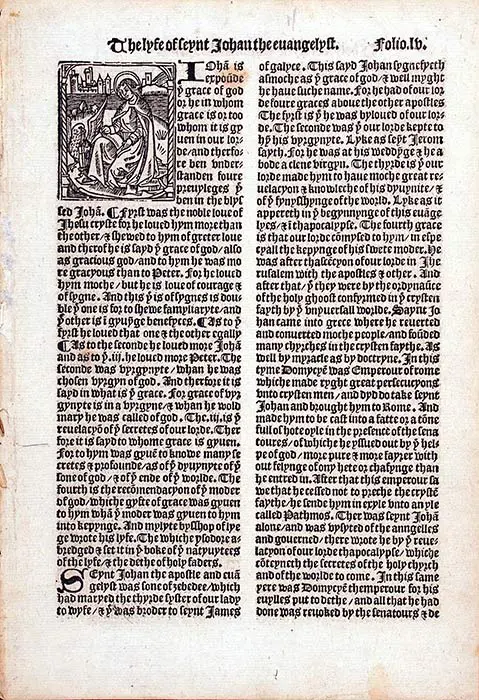Case 8
- Four Evangelists (Luke & John)

Single leaf from Jacobus de Voragine’s The Golden Legend. Westminster: Wynkyn de Worde, 1527. RPRF Eng. 1527/1
St. Luke, author of the third Gospel and the Book of Acts, is here portrayed writing his Gospel and wearing a physician’s hat, a sign of his former profession. Kneeling before his desk is St. Luke’s emblem, a winged ox.
The ox, a sacrificial animal which represents strength, service and sacrifice, was chosen for St. Luke because his Gospel begins with an account of Zechariah sacrificing in the temple and gives a full description of Christ’s sacrifice in his Passion and Crucifixion.

Single leaf from Jacobus de Voragine’s The Golden Legend. Westminster: Wynkyn de Worde, 1527. RPRF Eng. 1527/1
Open image in new window
![The New Testament of oure Sauyour Iesu Christ … [Antwerp]: Matthew Crom, 1538. RBP NT English 1538](https://www.reedgallery.co.nz/__data/assets/image/0003/221574/signs-case8-1.webp)
The New Testament of oure Sauyour Iesu Christ … [Antwerp]: Matthew Crom, 1538. RBP NT English 1538
As the youngest of the twelve apostles, St. John is the only one of the Four Evangelists depicted as a young, beardless man with long hair.
He is often shown with a book (seen here balanced across his leg) and an eagle, the latter signifying the elevated inspiration of his Gospel and Jesus Christ’s Ascension to the Heavens.
![The New Testament of oure Sauyour Iesu Christ … [Antwerp]: Matthew Crom, 1538. RBP NT English 1538](https://www.reedgallery.co.nz/__data/assets/image/0003/221574/signs-case8-1.webp)
The New Testament of oure Sauyour Iesu Christ … [Antwerp]: Matthew Crom, 1538. RBP NT English 1538
Open image in new window

![The New Testament of oure Sauyour Iesu Christ … [Antwerp]: Matthew Crom, 1538. RBP NT English 1538](https://www.reedgallery.co.nz/__data/assets/image/0003/221574/signs-case8-1.webp)